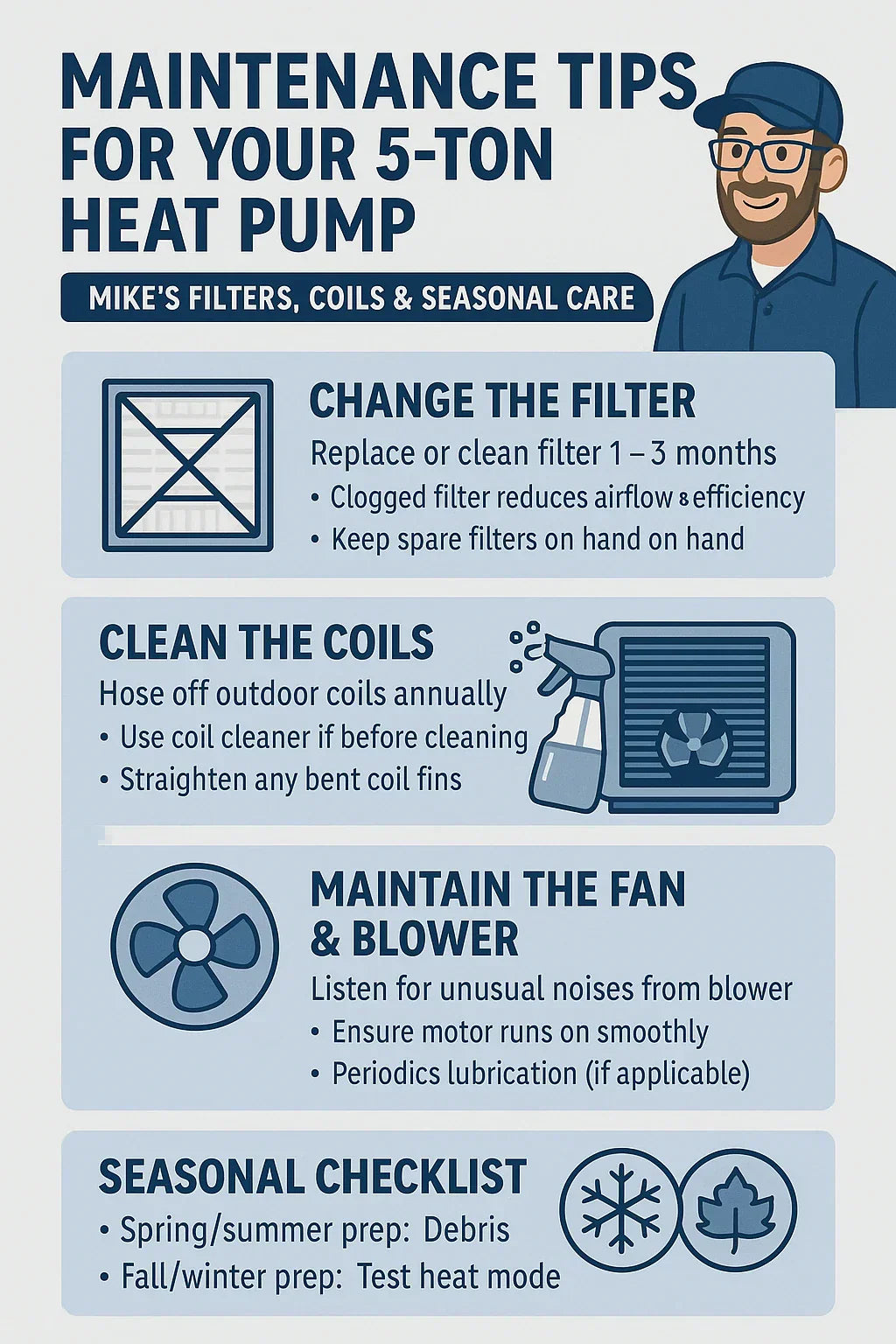🏠 Introduction: Why Maintenance Matters for Big Systems Like Yours
If you own a 5‑ton heat pump, you’ve got one of the largest residential HVAC systems available. That’s roughly 60,000 BTUs of heating and cooling power—plenty to keep a big home comfortable.
But here’s the catch: the bigger the system, the more important routine maintenance becomes. A neglected 5‑ton unit can:
-
Burn more electricity than necessary
-
Struggle with airflow, leaving rooms unevenly heated or cooled
-
Break down years before its expected lifespan
I’ve seen homeowners either save thousands through simple upkeep or pay thousands more for preventable repairs. In this guide, I’ll walk you through the essentials of keeping your 5‑ton system running like new.
🧼 Filter Maintenance: Your First Line of Defense
A clean filter is the simplest and cheapest way to keep your heat pump efficient.
📆 How Often to Change Filters
-
Standard filters (MERV 8–11): every 30–60 days
-
High-efficiency filters (MERV 12–13): every 60–90 days
-
Reusable/washable filters: rinse every 30 days
👉 Source: Lennox – How Often to Change HVAC Filters
🚨 Signs of a Dirty Filter
-
Rooms feel stuffy or uneven
-
Increased system noise
-
Dust buildup on vents
-
Higher electricity bills
Mike’s Tip:
“Buy filters in bulk so you never run out. A $10 filter swap can prevent a $400 service call.”
❄️ Evaporator & Condenser Coil Cleaning Tips
Your heat pump has two main coils:
-
Evaporator coil (inside) – absorbs heat
-
Condenser coil (outside) – releases heat
When coils are clogged, the system works harder and consumes more power.
🧽 How to Clean Coils Safely
-
Shut off power at the breaker.
-
Clear debris around the outdoor unit.
-
Use a garden hose (gentle spray) to rinse the condenser coil.
-
For stubborn dirt, apply foaming coil cleaner (available at hardware stores).
-
Straighten bent fins with a fin comb.
👉 Step‑by‑step: Carrier – Coil Cleaning Guide
When to Call a Pro
-
Coils have heavy compacted dirt
-
Fins are severely bent
-
System performance hasn’t improved after cleaning
Mike’s Tip:
“Think of your coils like your car’s radiator—keep them clean, and your system won’t overheat.”
🌬️ Fan & Blower Maintenance
The blower and fans move air through your ducts. Dirt or imbalance here causes strain on the entire system.
🔧 What to Check
-
Blower Wheel – Dusty blades reduce airflow
-
Fan Motor – Listen for humming or rattling noises
-
Lubrication – Some models require seasonal lubrication
-
Alignment – Ensure the wheel spins smoothly and without wobbling
Mike’s Tip:
“When your blower sounds different than usual, it’s telling you something. Don’t ignore it.”
🧊 Seasonal Checklist: Prepping for Summer & Winter
Here’s how I schedule maintenance for a 5‑ton system.
🌸 Spring Prep (Cooling Season)
-
Inspect refrigerant lines for cracks or insulation damage
-
Remove leaves, sticks, and grass clippings from around outdoor unit
-
Rinse condenser coils
-
Test thermostat calibration
-
Inspect and clear condensate drain
🍂 Fall Prep (Heating Season)
-
Switch to heat mode and test system startup
-
Verify defrost cycle operation
-
Inspect electric backup heat strips (if applicable)
-
Clean or replace indoor air filter
-
Check ductwork for leaks or blockages
👉 Official guidance: DOE – Heat Pump Maintenance
🧰 Tools & Supplies Mike Recommends
Having the right tools makes DIY maintenance easy.
-
Washable filters – cost-effective and eco-friendly
-
Fin comb – to straighten coil fins
-
Foaming coil cleaner – removes debris and grime
-
Cordless vacuum with brush – cleans blower and vents
-
Garden hose & sprayer – for outdoor coil cleaning
-
Zip ties – to tidy wiring around outdoor unit
👉 Handy shopping source: Home Depot – HVAC Maintenance Tools
🔄 When to Call a Pro vs. DIY
✅ DIY Jobs
-
Replacing or cleaning filters
-
Clearing debris from outdoor unit
-
Rinsing coils and cleaning fins
-
Vacuuming return vents and registers
⚠️ Pro‑Only Tasks
-
Checking refrigerant charge and pressure
-
Testing capacitors and electrical components
-
Repairing duct leaks in hard-to-access areas
-
Diagnosing defrost or compressor issues
👉 Guidance: When to Hire an HVAC Pro
Mike’s Rule of Thumb:
“If it involves refrigerant, high voltage, or inside-the-unit wiring, call a pro.”
📆 Creating a Maintenance Calendar That Works
A little organization goes a long way.
🗓️ Mike’s Routine
-
Monthly: Check filter, clear debris from outdoor unit
-
Every 3 months: Deep clean coils, check condensate drain
-
Spring & Fall: Run seasonal prep checklist
-
Annually: Schedule professional tune-up
Tips for Staying on Track
-
Set reminders on your phone or smart thermostat
-
Use a magnetic checklist on your fridge
-
Keep receipts/logs for service calls
👉 Downloadable checklists: ENERGY STAR HVAC Maintenance
✅ Conclusion: Mike’s Golden Rule
Think of your 5‑ton heat pump like a car:
-
Regular oil changes = filter swaps
-
Seasonal tire checks = coil cleanings
-
Annual inspection = professional tune-up
Neglect it, and you’ll pay more in the long run. Take care of it, and it’ll deliver 15–20 years of reliable comfort.
“If you treat your system like your car, it’ll last just as long—and cost you less.” — Mike Sanders
In the next topic we will know more about: Installation Guide: What Homeowners Should Know Before Installing a 5-Ton Heat Pump







